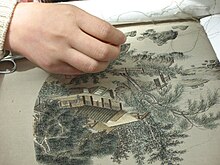


Chinese embroidery refers to embroidery created by any of the cultures located in the area that makes up modern China. It is some of the oldest extant needlework. The four major regional styles of Chinese embroidery are Suzhou embroidery (Su Xiu), Hunan embroidery (Xiang Xiu), Guangdong embroidery (Yue Xiu) and Sichuan embroidery (Shu Xiu). All of them are nominated as Chinese Intangible Cultural Heritage.
Chinese embroidery has a long history since the Neolithic age. Because of the quality of silk fibre, most Chinese fine embroideries are made in silk. Some ancient vestiges of silk production have been found in various Neolithic sites dating back 5,000–6,000 years in China. Currently the earliest real sample of silk embroidery discovered in China is from a tomb in Mashan in Hubei province identified with the Zhanguo period (5th–3rd centuries BC). After the opening of Silk Route in the Han dynasty, the silk production and trade flourished. In the 14th century, the Chinese silk embroidery production reached its high peak. Several major silk brocade styles had been developed, like Song Jin (宋锦 Song brocade) in Suzhou, Yun Jin (云锦 Cloud brocade) in Nanjing and Shu Jin (蜀锦 Shu brocade) in Sichuan.
Today, most handwork has been replaced by machinery, but some very sophisticated production is still hand-made. Modern Chinese silk embroidery by hand is still common in southern China.


Other Chinese ethnic groups, like Bai, Miao, Zhuang and Tibetan people also have their own style of embroidery, which usually depicts a mythical or religious topic.
|
| ||
|---|---|---|
| Styles |
| |
| Stitches |
| |
| Tools and materials |
| |
| Regional |
| |
| Embroideries |
| |
| Designers |
| |
| Organizations |
| |
| Related |
| |
| Authority control databases: National |
|
|---|